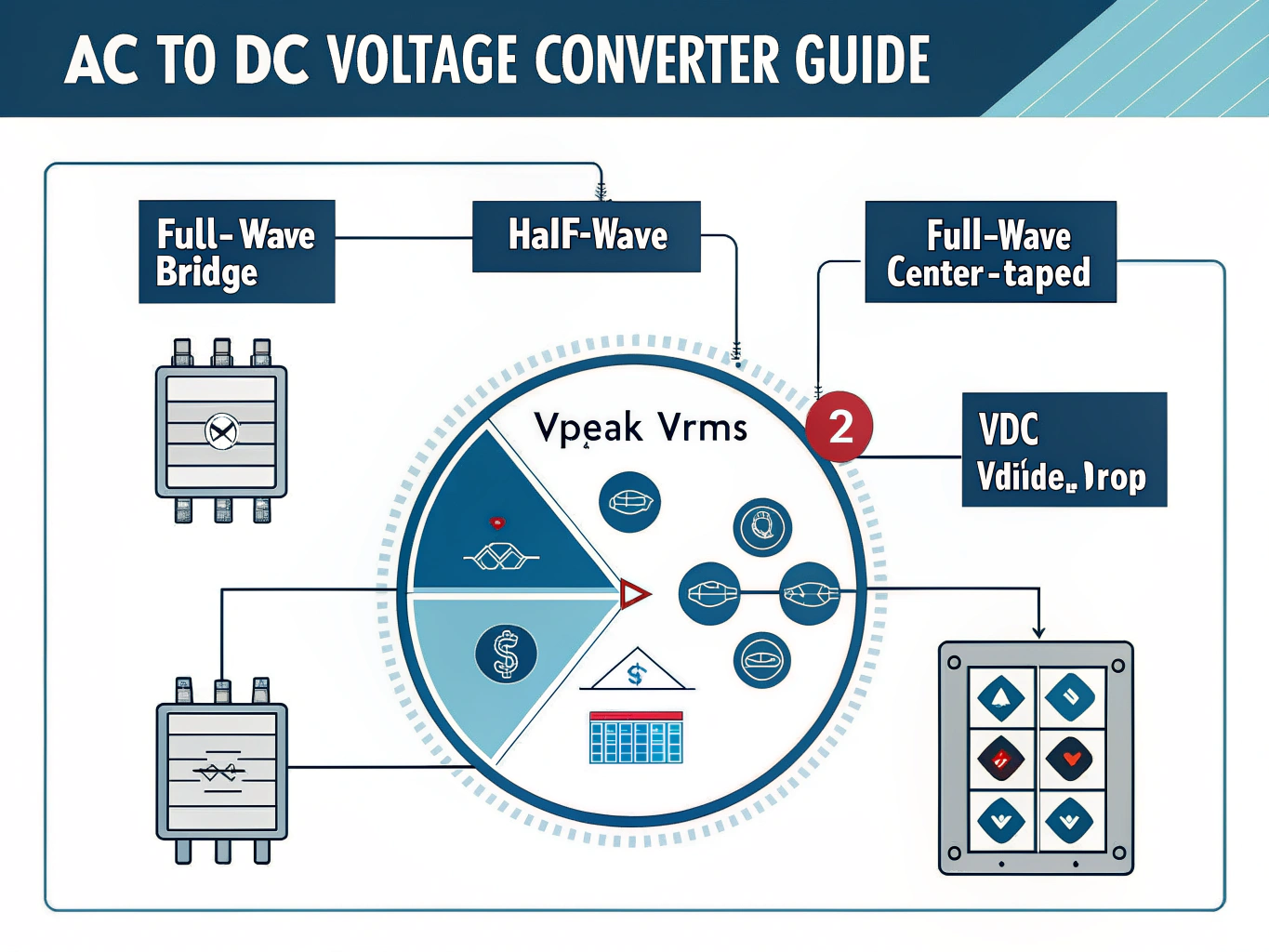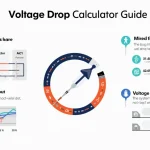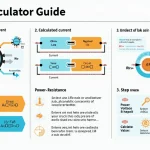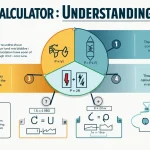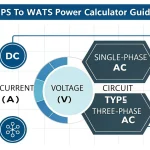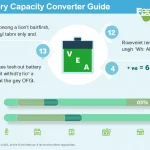AC to DC Converter
Is this tool helpful?
How to Use the AC to DC Voltage Converter Calculator Effectively
You can easily calculate the DC output voltage from an AC power source with this intuitive converter calculator. Follow these straightforward steps to get accurate results:
- Enter AC RMS Voltage: Input the root mean square (RMS) voltage of your AC source. For instance, try 110V for typical North American household voltage or 48V for telecommunications power systems.
- Set Diode Forward Voltage Drop: Specify the forward voltage drop per diode. The default is 0.7V, suitable for silicon diodes. You may adjust this to 0.4V if you use low-drop Schottky diodes or 1.0V for germanium diodes.
- Choose Rectifier Type: Pick one of the following configurations based on your circuit:
- Full-Wave Bridge Rectifier
- Half-Wave Rectifier
- Full-Wave Center-Tapped Rectifier
- View the Calculated Results: The calculator will display the following essential values:
- Peak Voltage (Vpeak)
- Total Diode Voltage Drop (Vtotal_diode_drop)
- DC Output Voltage (Vdc)
Understanding the AC to DC Voltage Converter Calculator
This online tool helps you determine the DC output voltage produced when converting AC voltage using different rectifier circuits. It accounts for factors like the AC RMS input voltage, diode forward voltage drops, and the type of rectifier setup you choose.
By calculating the peak voltage and subtracting the voltage losses across diodes, you can anticipate the actual DC voltage available, which is vital for designing efficient power supplies and electronic circuits.
Key Benefits of This AC to DC Voltage Converter Calculator
- Provides quick and accurate DC voltage estimations from AC inputs
- Supports multiple rectifier configurations to match your design needs
- Allows customization of diode forward voltage drop to improve precision
- Enhances efficiency in power supply design and troubleshooting
- Serves as an educational resource for understanding rectification concepts
Sample Calculations Using the Calculator
Example 1: Industrial Control Power Supply
- AC RMS Voltage: 48V
- Rectifier Type: Full-Wave Center-Tapped Rectifier
- Diode Forward Voltage Drop: 0.4V (Schottky Diode)
First, calculate the peak voltage:
$$V_{peak} = V_{rms} \times \sqrt{2} = 48 \times \sqrt{2} = 67.88 \text{ V}$$
Since this rectifier type uses one diode per conduction path, total diode voltage drop is:
$$V_{total\_diode\_drop} = 0.4 \text{ V}$$
The DC output voltage then is:
$$V_{dc} = \frac{2 \times V_{peak}}{\pi} – V_{total\_diode\_drop} = \frac{2 \times 67.88}{3.1416} – 0.4 = 42.65 \text{ V}$$
Example 2: Low Voltage LED Driver
- AC RMS Voltage: 12V
- Rectifier Type: Half-Wave Rectifier
- Diode Forward Voltage Drop: 1.0V (Germanium Diode)
Calculate the peak voltage:
$$V_{peak} = 12 \times \sqrt{2} = 16.97 \text{ V}$$
Half-wave rectifiers use one diode, so:
$$V_{total\_diode\_drop} = 1.0 \text{ V}$$
DC output voltage is:
$$V_{dc} = \frac{V_{peak}}{\pi} – V_{total\_diode\_drop} = \frac{16.97}{3.1416} – 1.0 = 4.4 \text{ V}$$
The Science Behind AC to DC Voltage Conversion
Electric devices typically require direct current (DC) to operate. Since most power sources provide alternating current (AC), converting AC to DC is essential. Rectifier circuits allow this conversion by directing current flow and blocking the reverse direction.
Mathematical Foundations
Key relationships for understanding conversion include:
- Peak voltage from RMS voltage:
$$V_{peak} = V_{rms} \times \sqrt{2}$$
- DC output voltage considering diode drops and configuration:
$$V_{dc} = \frac{2 \times V_{peak}}{\pi} – V_{total\_diode\_drop} \quad \text{(Full-Wave Rectifiers)}$$
$$V_{dc} = \frac{V_{peak}}{\pi} – V_{total\_diode\_drop} \quad \text{(Half-Wave Rectifier)}$$
Rectifier Types and Voltage Drop Effects
Different rectifier topologies influence diode conduction and voltage drops:
- Full-Wave Bridge Rectifier: Two diodes conduct simultaneously during each half cycle, causing a total voltage drop of
$$V_{total\_diode\_drop} = 2 \times V_{diode}$$ - Half-Wave Rectifier: A single diode conducts per half cycle, so:
$$V_{total\_diode\_drop} = V_{diode}$$ - Full-Wave Center-Tapped Rectifier: One diode conducts per half cycle, resulting in:
$$V_{total\_diode\_drop} = V_{diode}$$
Applying the AC to DC Voltage Converter Calculator in Real-World Scenarios
Designing a Power Supply
If you want to design a 36V DC power supply from 25V AC mains, input 25V RMS voltage, select a full-wave bridge rectifier, and use silicon diodes with a 0.7V forward voltage drop. The calculator provides the peak voltage, total diode drop, and predicted DC voltage, helping you size components and regulate voltage.
Developing LED Drivers
When working on LED driver circuits powered from AC sources, you can use this calculator to estimate the DC voltage after rectification. Adjust diode forward voltage according to the diode type used in the circuit, ensuring the correct current and voltage ratings for your LEDs.
Common Use Cases of the AC to DC Voltage Converter Tool
Consumer Electronics
- Smartphone and tablet chargers
- Laptop and desktop power adapters
- LED lighting power supplies
- Home and office appliance power conversion
Industrial and Commercial Applications
- Motor controller power supplies
- Automation equipment power circuits
- Process control system power design
- Custom power supply development
Frequently Asked Questions About AC to DC Voltage Conversion
What does RMS voltage mean?
RMS (Root Mean Square) voltage is the effective value of alternating current that delivers the same energy as an equivalent direct current voltage. It is approximately 0.707 times the peak voltage.
Why are there different rectifier types?
Rectifier types trade off complexity, cost, and output quality. Half-wave rectifiers are simpler but produce more ripple, while full-wave rectifiers offer smoother DC outputs but require more components.
How should I select the diode for my rectifier circuit?
Choose diodes based on forward voltage drop, current rating, switching speed, and operating temperature. Low-drop diodes like Schottky types improve efficiency but may cost more.
Why is the diode forward voltage drop significant?
The diode voltage drop decreases the DC output voltage and affects power efficiency. Lower drops yield higher output but may require more expensive components.
Can the calculator handle three-phase AC inputs?
This tool focuses on single-phase AC to DC conversion. Three-phase systems have different rectification methods and require separate calculations.
Design Considerations for AC to DC Power Conversion
Selecting Components
- Ensure voltage ratings exceed peak voltages
- Support current requirements with appropriate diode ratings
- Plan for heat dissipation to avoid thermal issues
- Balance component cost with efficiency needs
Safety and Reliability
- Use proper isolation between AC and DC sides
- Verify component voltage and current ratings
- Implement adequate heat management solutions
- Include fuses or circuit breakers for protection
Important Disclaimer
The calculations, results, and content provided by our tools are not guaranteed to be accurate, complete, or reliable. Users are responsible for verifying and interpreting the results. Our content and tools may contain errors, biases, or inconsistencies. We reserve the right to save inputs and outputs from our tools for the purposes of error debugging, bias identification, and performance improvement. External companies providing AI models used in our tools may also save and process data in accordance with their own policies. By using our tools, you consent to this data collection and processing. We reserve the right to limit the usage of our tools based on current usability factors. By using our tools, you acknowledge that you have read, understood, and agreed to this disclaimer. You accept the inherent risks and limitations associated with the use of our tools and services.
